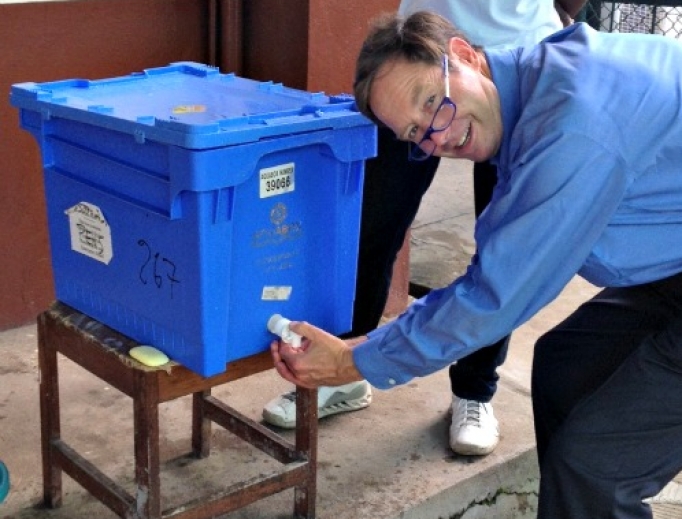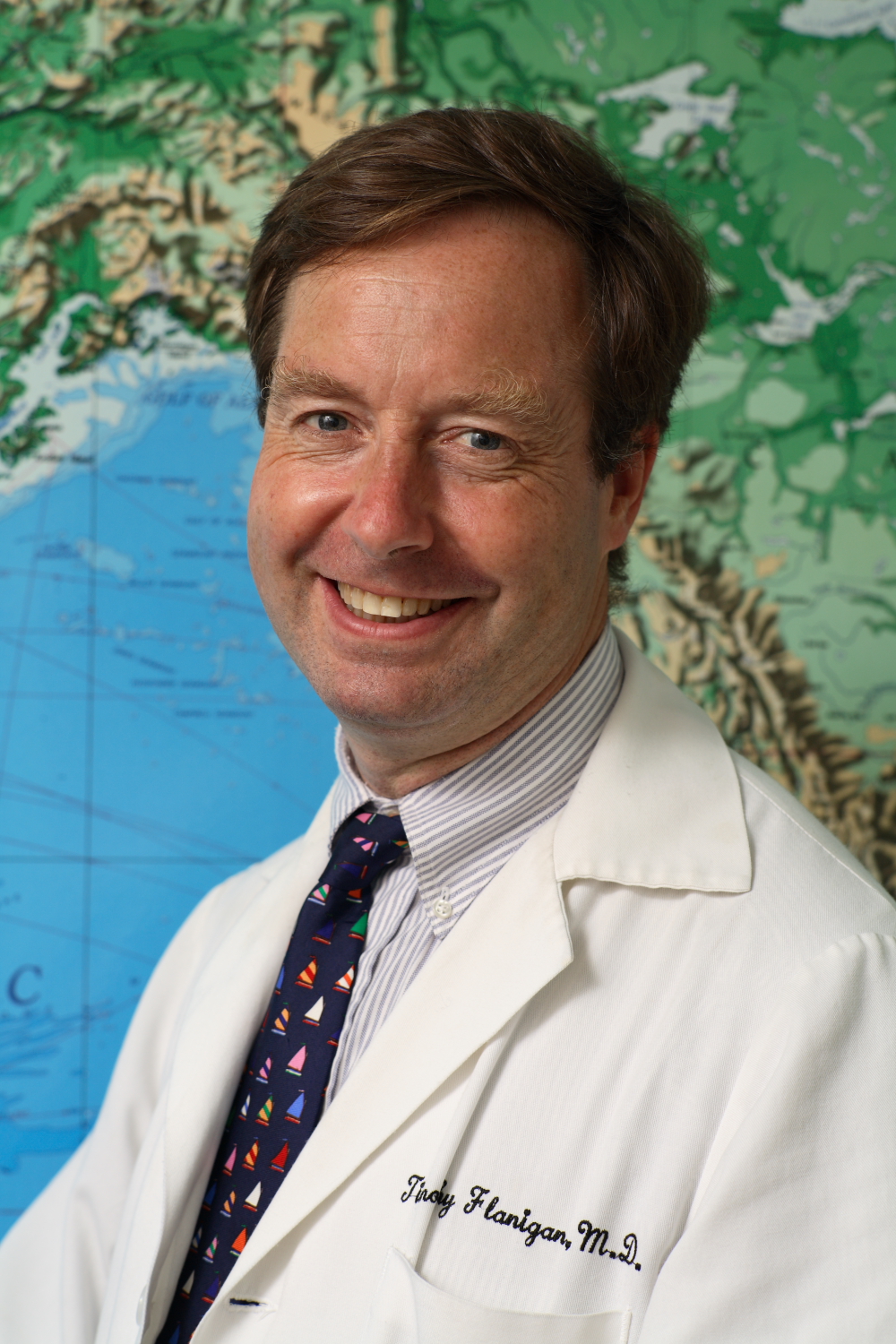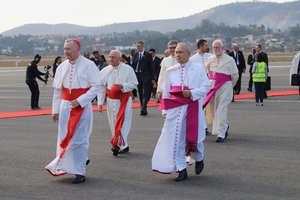Doctor: Keep Calm and Take Practical, Prayerful Action Amid Coronavirus
Dr. Timothy Flanigan, a Catholic deacon and infectious disease specialist at Brown University, says Catholics and their parishes can take safe, practical action in response to the global spread of COVID-19.

PROVIDENCE, R.I. — The novel coronavirus COVID-19 has spread all over the globe, causing tens of thousands to fall ill and hitting hard communities and the global economy. But even in this time of great uncertainty, the Catholic Church has a critical role to play in providing hope and the life-giving sacraments of Jesus Christ.
In this interview with Register staff writer Peter Jesserer Smith, Dr. Timothy Flanigan, a Catholic deacon and professor of medicine in the Division of Infectious Disease at Brown University’s Alpert Medical School, discusses the concerns of the coronavirus compared to other outbreaks, which groups are vulnerable, and also what parishes and individual Catholics can do to face it calmly and help others carry their crosses during this time.
Dr. Flanigan, how deadly is the coronavirus, COVID-19? Are the concerns about a global pandemic overblown or spot-on, in your estimation?
I don’t think the concerns are overblown. The mortality of this virus is probably going to be between 1%-2%. It is not exactly clear. It is relatively easy to spread, but it’s not going to cause illness, mortality or death the way the Black Plague did [reporter’s note: 35% mortality rate]. So when people equate it to the plague, that’s incorrect and wrong.
We will be able to provide good care, we’ll be able to identify it, and we will be able to slow the spread down. We will end up with treatment for it, and we will end up getting a vaccine. It’s just unclear how long it will be until we have a vaccine and good treatment.
Which population groups are most vulnerable to coronavirus?
Older folks are more likely to become more ill. Children and young people, if they become infected, tend to not become ill and not become seriously ill. That’s very encouraging, especially for younger people.
Why do we see the level of concern that we have now?
First, it’s new. Whenever we have a new infection like this, it causes fear. And fear is real. It’s part of our DNA. We have to acknowledge it. It is the reality.
The second is the mortality rate of COVID-19 might be 1%, and that is 10 times the mortality rate of influenza. So it is significant. For different communities, different families and different individuals, that can mean a terrible illness and a terrible loss. So I don’t believe that the concern in general is overblown.
The CDC [Centers for Disease Control and Prevention] and the government is really calling for us to have a new way of doing things, where we all participate in what’s called “social distancing.” Social distancing is where the community says, “We’re going to help halt this new coronavirus as well as slow down the spread of other viral respiratory infections, such as influenza.”
How does COVID-19 compare with the influenza types that we currently see, especially the ones this year?
We’re in a relatively bad flu season, with high levels of circulating influenza. The flu vaccine is partially effective. It’s expected to be about 45% effective this year. We have oral treatment for flu, where we have flu medication, which goes by the name oseltamivir or the trade name Tamiflu.
We do have experimental treatments for COVID-19, but they are in development, so we have had to respond in other ways to decrease the spread. We respond as a community to the influenza epidemic that comes to us each year, but every year we see individuals who, unfortunately, develop the flu and die, which, thankfully, is very rare. And that is just as much a tragedy as individuals who develop the novel coronavirus infection and become very ill.
What are some ways that parishes and ministries should deal with the coronavirus?
We really aren’t sure yet the extent of community transmission. The CDC is doing a great job looking into it, but this is literally unfolding. So, for me, we know that this is spread primarily through droplets. So that means you cough on your hand, you shake somebody else’s hand, they then rub their nose, and, voila, the virus gets into the mucous membrane.
How can we stop that transmission?
We know that the virus does not penetrate intact skin. We know it gets into mucous membranes, and we know it spreads to the mucous membrane by these microscopic droplets: when you sneeze, or you blow your nose, or you cough on your hands. We know that’s how it gets in there. So what can you do?
Anybody who’s ill, whether they have a fever, or cough, or they’re sneezing or have a respiratory infection, should not go to church and avoid any situation with very tight crowds. You could stay at home and tune into Mass on TV or the internet. We know that during a time when coronavirus (aka COVID-19) might be circulating, particularly in your state, that it is a good time to forgo Communion from the chalice. And there’s the option of forgoing offering the handshake at the Sign of Peace. We can acknowledge each other in a kind and friendly manner with a smile. Normal distances at church do not pose any significant risk.
When you’re with other people at a normal distance of a few feet, that does not pose risk of transmission through droplets. Avoiding situations with very tight crowds is another way to stop the spread. We can also remember before going out to wash our hands, or to use alcohol-based hand gels, and to do the same when coming back home. We might also choose to stop shaking hands routinely and just give a friendly bow or greeting.
Can you give an example from your own experience?
I saw this being done during the Ebola epidemic when I was in Liberia. [Reporter’s note: Ebola has a 50% mortality rate.] The churches remained open. And the churches were an extraordinary support for families and communities that were fearful or under tremendous stress or suffering from great sorrow. The churches provided phenomenal solace and were a real avenue of grace.

The priests also learned that they could administer the sacraments safely. The Host was placed on the hands without touching skin to skin. Confession was done at an arm’s length, and that, obviously, can be done without any difficulty. Even the last rites were performed with the blessing with the oil done with a cotton swab with Ebola-struck patients. But the priests showed extraordinary courage, and they knew in their bones they were bringing Jesus to their flocks. Even though many of them were fearful, and were anxious, they were there. They were present. The sacraments are the visible presence of grace and Jesus being present. And they lived that to an extraordinary degree. And I can’t tell you what it meant for their flock.
People are going to be seeking the sacraments, especially when they’re sick or dying. How can we protect priests, deacons and lay ministers who are trying to carry out those sacramental and pastoral roles?
Even in the hospital setting, the sacraments can be delivered with appropriate PPE, personal protective equipment. Chaplains, priests and lay ministers can be trained to wear it and are able to be present in that way in a safe manner.
What about a non-hospital setting, such as the church?
People who are ill should stay at home.
There shouldn’t be a setting where one needs to wear protective equipment [in church]. …
Whether it’s the pastor being sick, or the parishioner being sick, or the deacon being sick, they ought to be at home.
With regard to social distancing, do we have any sense of how successful it can be?
In West Africa, social distancing was very successful. The community realized that it was important for their own sake and for their own families. People did it very effectively — much more effectively than experts ever predicted. When people realize they can keep themselves safe, they can decrease the threat of respiratory viruses, including the novel coronavirus; they become heavily incentivized to really do it and put it into action.
In the meantime, if people are sick with coronavirus, how are they going to be able to keep supporting themselves if they can’t go to work and they don’t have savings to support themselves? What can our parishes do?
We all need to help each other out.
There are three things we have to do during Lent: We have to pray, we have to fast, and we have to do almsgiving; and that means helping those that are poor or are in need. And that might mean someone whose job is at risk — maybe not due to coronavirus infection, but maybe from the [resulting] economic downturn; maybe helping those that are in debt or maybe those that are having trouble paying their taxes on their house or paying their oil bill. It’s very, very concrete, but also very real. And I think the Church and the Lord ask us to be real in our living out charity; not as an abstract idea, but really saying: What does this mean in the concrete [real-life situations]?
What if COVID-19 becomes the new normal?
If we develop an effective vaccine and we develop effective treatment, in effect, the mortality may eventually decrease, so it might be similar to influenza. We don’t know. It may well be here to stay, as it is much more easily transmitted than other viruses such as MERS and SARS. So we may have subsequent waves, but those waves will be attenuated by a vaccine; and individuals that are seriously ill will hopefully have treatment in the same way that we do for influenza, which makes a big difference.
Thank you for sharing all this. Last thought: What actions can lay Catholics undertake individually and collectively to help out?
First and foremost, “keep calm and carry on” is super important, because we all have work to do. We’re all part of families and play critical roles, whether it’s parents or children or grandparents, spouses or friends.
We play important key roles in our small circles, and in our larger community circles, and we need to play those unless we have a respiratory infection, in which case we should stay home until that passes. So keeping calm and carrying on is really important.
The second is changing our day-to-day way of life, in the sense of not shaking hands, not hugging — or inviting others to otherwise do that; social distancing; using handwashing or alcohol-based hand rub. That can really make a big difference and can break the chain of transmission. So that’s very, very important. And then supporting those that are either under quarantine or those that suffer the difficulties of having the actual infection, recognizing that they need our prayers. They need the support of our faith to help strengthen their faith while they carry this cross. We never carry the cross alone.
This interview is edited for length and content.
Peter Jesserer Smith is a Register staff writer.
- Keywords:
- coronavirus
- covid-19
- infectious disease
- pandemics


















